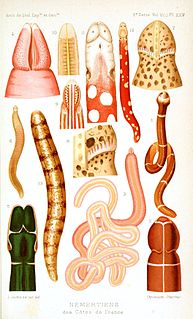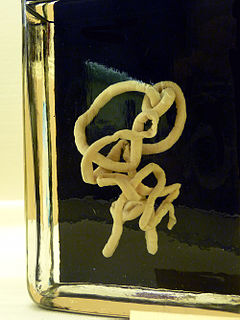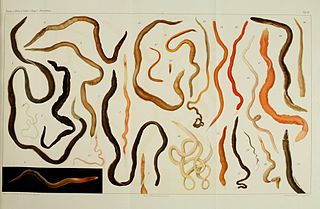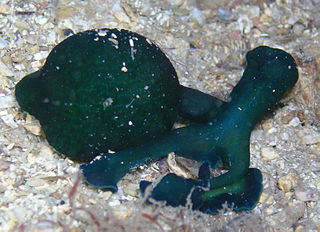
The Sipuncula or Sipunculida is a group containing about 162 species of bilaterally symmetrical, unsegmented marine worms. The name Sipuncula is from the genus name Sipunculus, and comes from the Latin siphunculus meaning a "small tube". Sipuncula seems to be closely related to Myzostomida, and Annelida.

The Echiura, or spoon worms, are a small group of marine animals. Once treated as a separate phylum, they are now considered to belong to Annelida. Annelids typically have their bodies divided into segments, but echiurans have secondarily lost their segmentation. The majority of echiurans live in burrows in soft sediment in shallow water, but some live in rock crevices or under boulders, and there are also deep sea forms. More than 230 species have been described. Spoon worms are cylindrical, soft-bodied animals usually possessing a non-retractable proboscis which can be rolled into a scoop-shape to feed. In some species the proboscis is ribbon-like, longer than the trunk and may have a forked tip. Spoon worms vary in size from less than a centimetre in length to more than a metre.

Nemertea is a phylum of invertebrate animals also known as ribbon worms or proboscis worms. Alternative names for the phylum have included Nemertini, Nemertinea and Rhynchocoela. Most are very slim, usually only a few millimeters wide, although a few have relatively short but wide bodies. Many have patterns of yellow, orange, red and green coloration. The foregut, stomach and intestine run a little below the midline of the body, the anus is at the tip of the tail, and the mouth is under the front. A little above the gut is the rhynchocoel, a cavity which mostly runs above the midline and ends a little short of the rear of the body. All species have a proboscis which lies in the rhynchocoel when inactive but everts to emerge just above the mouth and capture the animal's prey with venom. A highly extensible muscle in the back of the rhynchocoel pulls the proboscis in when an attack ends. A few species with stubby bodies filter feed and have suckers at the front and back ends, with which they attach to a host.

Oligochaeta is a subclass of animals in the phylum Annelida, which is made up of many types of aquatic and terrestrial worms, including all of the various earthworms. Specifically, oligochaetes comprise the terrestrial megadrile earthworms, and freshwater or semiterrestrial microdrile forms, including the tubificids, pot worms and ice worms (Enchytraeidae), blackworms (Lumbriculidae) and several interstitial marine worms.

Anopla has long been used as name for a class of marine worms of the phylum Nemertea, characterized by the absence of stylets on the proboscis, the mouth being below or behind the brain, and by having separate openings for the mouth and proboscis. The other long used class of Nemertea are the Enopla. Although Anopla is a paraphyletic grouping, it is used in almost all Scientific classifications. Anopla is divided into two orders: Palaeonemertea and Heteronemertea.

Palaeonemertea is an order of primitive nemertean worm. It may be para- or polyphyletic, consisting of three to five clades and totalling about 100 species.

Enopla is one of the classes of the worm phylum Nemertea, characterized by the presence of a peculiar armature of spines or plates in the proboscis.

Chaetopterus or the parchment worm or parchment tube worm is a genus of marine polychaete worm that lives in a tube it constructs in sediments or attaches to a rocky or coral reef substrate. The common name arises from the parchment-like appearance of the tubes that house these worms. Parchment tube worms are filter feeders and spend their adult lives in their tubes, unless the tube is damaged or destroyed. They are planktonic in their juvenile forms, as is typical for polychaete annelids. Species include the recently discovered deep water Chaetopterus pugaporcinus and the well-studied Chaetopterus variopedatus.

Cirratulidae is a family of marine polychaete worms. Members of the family are found worldwide, mostly living in mud or rock crevices. Most are deposit feeders, but some graze on algae or are suspension feeders.
Gononemertes is a genus of parasitic worms.

Protomicrocotylidae is a family of monogenean parasites in the order Mazocraeidea.

Phyllodocidae is a family of polychaete worms. Worms in this family live on the seabed and may burrow under the sediment.

Tubulanus polymorphus is a species of ribbon worm in the phylum Nemertea. It is found in the northern Atlantic Ocean and the northern Pacific Ocean. It occurs on the lower shore down to about 50 m (160 ft), on sand or gravel, under stones and among seaweed.

Tubulanus is a genus of primitive nemertean worms in the order Palaeonemertea.

Tubulanus superbus, commonly known as the football jersey worm, is a species of ribbon worm in the phylum Nemertea. Found in the northern Atlantic Ocean, the North Sea and the Mediterranean Sea, it occurs from the lower shore down to about 80 m (260 ft), on sand or gravel.

Cerebratulus lacteus, the milky nemertean or milky ribbon worm, is a proboscis worm in the family Lineidae. This ribbon worm has a wide geographical range on both sides of the northern Atlantic Ocean.

Cerebratulus marginatus is a proboscis worm in the family Lineidae. This ribbon worm has an Arctic distribution, and in the North Atlantic Ocean ranges as far south as Cape Cod and the Mediterranean Sea while in the Pacific Ocean it extends southwards to California.

Tracheloraphis is a genus of ciliates in the family Trachelocercidae.

Bonelliidae is a family of marine worms noted for being sexually dimorphic, with males being tiny in comparison with the females. They occupy burrows in the seabed in many parts of the world's oceans, often at great depths.
Sternaspidae, commonly known as mud owls, are a family of marine polychaete worms with short swollen bodies. They have a global distribution and live buried in soft sediment at depths varying from the intertidal zone to 4,400 m (14,400 ft).

















